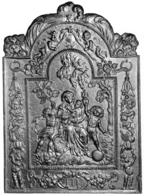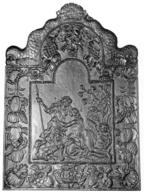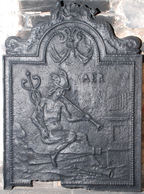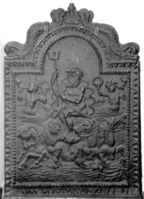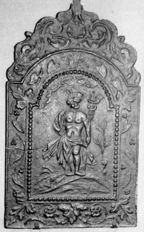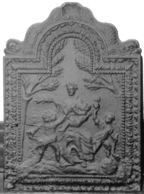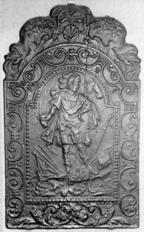-
308
Description: Arched rectangular centrel panel with bead on fillet edging; central seated female with an infant in her arms, a swan at her feet and a standing child on each side, the one to her left facing the front and holding aloft a flaming heart, its foot on a ball; the child to her right facing the back, holding aloft a branch in its left hand, all on a ground with a tree behind to the right; arched rectangular border with fillet edging; at the top of the arch a cartouche from which are suspended two ribbons, each held by a putto, from which cascade flowers and fruit, each lower part hung from a ring; two putti are on each side, one climbing on the suspended ribbon, the other at its foot; at the bottom, a cartouche containing the monogram between two clusters of flowers each suspended on a ribbon tied to a scroll; on top, two descending cornucopiae.
Notes: The scene portrays Charity; the same central panel can be seen with different borders, and also exists in other versions.
Copies of this fireback are known.
Inscription: HIS
- Decoration tags:
- 'Dutch' (shape)
- fillet (edging)
- whole carved pattern
- pictorial
- allegorical
- monogram
- text
- humans
Manufactured: in the late-17th century in the Siegerland area of Germany.
Current location: Hampton Court Palace, Richmond, Greater London, England.
Museum number: 1069 (part of the Royal Collection museum group)
- Attached to series:
- 'Dutch' HIS series
- Charity firebacks
-
309
Description: Central panel, cavetto-canted rectangle with arch; bud and annulet edging (in alternate threes); pictorial panel portraying Europa being carried to sea by Zeus, disguised as a bull; two female attendants wave from the right shore; two putti attend, one below with a bow and arrow; trees to right and left; clouds and sun above. Same shaped, fillet-edged border with floral scrolls top and sides; at the bottom, a cartouche bearing EB monogram between oak leaf and acorn fronds; on top, central scallop shell between floral scrolls with dolphin’s heads.
Notes: The central design is closely based on an illustration by Bernard Salomon, first published in a 1557 edition of Ovid’s Metamorphoses and copied in subsequent editions by Virgil Solis (1514-62). The initials, EB, are likely to be those of the pattern maker. The similarity between the execution of this picture and those on firebacks bearing the SHR monogram suggests the possibility of a common source. Ten rivets are the result of later repair.
Copies of this fireback are known.
Inscription: EB
- Decoration tags:
- 'Dutch' (shape)
- fillet (edging)
- whole carved pattern
- pictorial
- mythological
- monogram
- text
- animals
- humans
Manufactured: in the early-18th century in England.
Current location: Hampton Court Palace, Richmond, Greater London, England.
Museum number: 1107 (part of the Royal Collection museum group)
- Attached to series:
- EB series
- British 'Dutch' style firebacks
-
310
Description: Arched rectangular central panel with bead edging; pictorial scene of Venus, naked and kneeling, and Adonis, standing, holding a spear in his left hand, with Cupid to the left, and a hound and a quiver of arrows below to the right; arched rectangular border with fillet edging; descending swags of fruit and seashells enclosing the central panel; inscription in an oval cartouche at the bottom; on top, a Holy Roman Imperial crown between two mirrored dolphins, heads downward.
Notes: The scene is based on the painting (c.1635) of Venus and Adonis by Peter Paul Rubens; the initials, L8G, denote the style of border - other firebacks having the same inscription have the same border - and other borders are denoted by similar inscriptions (e.g. L6C and L7C). Von den Driesch (p.520) illustrates the same central image within an L7C border.
Copies of this fireback are known.
Inscription: L8G
- Decoration tags:
- 'Dutch' (shape)
- fillet (edging)
- whole carved pattern
- pictorial
- mythological
- text
- humans
Manufactured: in the late-17th century in the Siegerland area of Germany.
Current location: Hampton Court Palace, Richmond, Greater London, England.
Museum number: 1042 (part of the Royal Collection museum group)
- Attached to series:
- 'Dutch' LC/G series
- 'Dutch' Venus and Adonis firebacks
-
97
Description: Arched rectangular shaped central panel with bead edging; naked figure of Mercury/Hermes with winged helmet (petasos), holding a snake-entwined staff (caduceus); he is sitting astride a pair of bellows and blowing a straight trumpet; a twice-bent trumpet lies at his feet; the bellows are pumping air into an organ; to the right of his head is the word, AER (air - Latin); above is a swag of drapery; arched rectangular shaped border with ovolo edging; floral wreath at top with suspended swags of fruit and leaves, including, grapes, pomegranates and apples; inscription, ‘ANNO 1661’, on a scroll at the bottom; scallop shell and sea serpents on top.
Notes: One of a series of firebacks symbolising the four elements.
Copies of this fireback are known.
Inscription: AER / ANNO 1667
- Decoration tags:
- 'Dutch' (shape)
- ovolo (edging)
- whole carved pattern
- mythological
- allegorical
- text
- humans
- objects
Manufactured: in 1667 possibly in the Siegerland area of Germany.
Current location: Nymans, Staplefield Road, Handcross, Slaugham, West Sussex, England.
Museum number: 1206008 (part of the National Trust museum group)
- Attached to series:
- 'Dutch' Miscellaneous Firebacks
- Elements firebacks
-
98
Description: Arched rectangular shaped central panel with bead edging; naked figure of Mercury/Hermes with winged helmet (petasos), holding a snake-entwined staff (caduceus); he is sitting astride a pair of bellows and blowing a straight trumpet; a twice-bent trumpet lies at his feet; the bellows are pumping air into an organ; to the right of his head is the word, AER (air - Latin); above is a swag of drapery; outside the panel is a narrow border of the same shape with fillet edging; the fireback is surmounted by a scallop shell between two outward-facing sea serpents.
Notes: One of a series of firebacks symbolising the four elements.
Copies of this fireback are known.
Inscription: AER
- Decoration tags:
- 'Dutch' (shape)
- fillet (edging)
- whole carved pattern
- mythological
- allegorical
- text
- humans
- objects
Manufactured: in the mid- to late-17th century in England.
Current location: Nymans, Staplefield Road, Handcross, Slaugham, West Sussex, England.
Museum number: 1206021 (part of the National Trust museum group)
- Attached to series:
- 'Dutch' Miscellaneous Firebacks
- Elements firebacks
-
104
Description: 'Dutch' style; arched rectangular shaped central panel with arch at top; bead edging; female figure with staff and fan in a garden, inscription DER MITAG below figure ; similarly shaped border of Corinthian columns and floral decoration; symmetrical serpents on top.
Notes: The inscription means NOON; identified from a clearer version in the collection of the Haardplatenmuseum, Klarenbeek, Netherlands. The representations in human form of various virtues and vices in Iconologia, by Cesare Ripa, first published in the early 17th century but republished in different editions many times subsequently, formed the basis of the subject matter of several firebacks, mostly cast from continental originals, that became popular in England from the late 17th century.
Copies of this fireback are known.
Inscription: DER MITAG
- Decoration tags:
- 'Dutch' (shape)
- fillet (edging)
- whole carved pattern
- pictorial
- allegorical
- text
- humans
Manufactured: in the mid- to late-17th century possibly in the Siegerland area of Germany.
Current location: Haslemere Educational Museum, Haslemere, Surrey, England.
(part of the Haslemere Educational Museum museum group)
- Attached to series:
- 'Dutch' Miscellaneous Firebacks
-
110
Description: Arched rectangular shaped central panel with fillet and bead edging, Neptune/Poseidon, holding a trident in his right hand, sitting in a scallop shell drawn by four mythical sea horses, behind are two mermaids; arched rectangular shaped border with ovolo egg and dart edging; above, two symmetrical dolphins with a clam shell between.
Notes: Typical type of firebacks produced in Germany for the Dutch market; the central panel was made separately for insertion into different borders; this border is a relatively simple type. Formerly part of the Ade Collection (from Grove Hill, Hellingly, Sussex).
Copies of this fireback are known.
- Decoration tags:
- 'Dutch' (shape)
- ovolo, egg and dart (edging)
- carved pattern panels
- mythological
- animals
- humans
Manufactured: in the mid- to late-17th century possibly in the Siegerland area of Germany.
Current location: Hastings Museum and Art Gallery, John's Place, Bohemia Road, Hastings, East Sussex, England.
Museum number: HASMG: 1952.51.36 (part of the Hastings Museum museum group)
Citation: Lloyd, N., 1925, 'Domestic Ironwork I', Architectural Review, 58, pp. 58-67.
- Attached to series:
- 'Dutch' Miscellaneous Firebacks
- 'Dutch' Dolphin series
-
111
Description: 'Dutch' style; arched rectangular shaped central panel with bead edging, semi-naked figure holding a caduceus in his left hand, standing on a mound with a tree to the right and clouds above; arched rectangular shaped border with fillet edging and an ivy and acanthus leaf pattern; on top an arrangement of swirled foliage.
Notes: The figure is Hermes/Mercury, one of a set of 'Eight Deities' engraved by Hendrick Goltzius (1592), after Polidoro da Caravaggio. Formerly part of the Ade Collection (from Grove Hill, Hellingly, Sussex).
Copies of this fireback are known.
- Decoration tags:
- 'Dutch' (shape)
- fillet (edging)
- whole carved pattern
- mythological
- humans
Manufactured: in the mid- to late-17th century in England.
Current location: Hastings Museum and Art Gallery, John's Place, Bohemia Road, Hastings, East Sussex, England.
Museum number: HASMG: 1952.51.34 (LA 782) (part of the Hastings Museum museum group)
- Attached to series:
- British 'Dutch' style firebacks
- Eight Deities series
-
138
Description: 'Dutch' style; arched rectangular shaped central panel with bead edging, figure of Charity holding a baby in her left arm and an olive branch in her right, two other children stand on each side of her, one holding a burning heart, trees in the background; arched rectangular shaped border with fillet edging and a repeated leaf pattern; on top a clam shell between two symmetrical serpents.
Notes: Typical type of fireback produced in Germany by Dutch pattern makers; the central panel was made separately for insertion into different borders; this border is a relatively simple type; the portrayal of Charity is derived from the 'Iconologia' of Cesare Ripa. Formerly part of the Ade Collection (from Grove Hill, Hellingly, Sussex).
Copies of this fireback are known.
- Decoration tags:
- 'Dutch' (shape)
- fillet (edging)
- carved pattern panels
- allegorical
- humans
- plants
Manufactured: in the mid- to late-17th century possibly in the Siegerland area of Germany.
Current location: Hastings Museum and Art Gallery, John's Place, Bohemia Road, Hastings, East Sussex, England.
Museum number: HASMG: 1952.51.40 (part of the Hastings Museum museum group)
Citation: Lloyd, N., 1925, 'Domestic Ironwork I', Architectural Review, 58, pp. 58-67.
- Attached to series:
- 'Dutch' Miscellaneous Firebacks
- Charity firebacks
-
130
Description: Arched rectangular shaped central panel with bead on fillet edging; helmeted figure of Mars holding a cutlass in his right hand, standing on a field of flags, spears and cannon; 'Palladian' shaped border with fillet edging enclosing a repeated scrollwork pattern with floral arrangement at base; on top, symmetrical arrangement of scallop shell between two sea serpents and plant fronds.
Notes: Although in the 'Dutch'; style, an absence of this type in continental collections suggests an British source. Formerly part of the Ade Collection (from Grove Hill, Hellingly, Sussex).
Copies of this fireback are known.
- Decoration tags:
- 'Dutch' (shape)
- fillet (edging)
- whole carved pattern
- mythological
- humans
Manufactured: in the late-17th to early-18th century in England.
Current location: Hastings Museum and Art Gallery, John's Place, Bohemia Road, Hastings, East Sussex, England.
Museum number: HASMG: 1952.51.32 (part of the Hastings Museum museum group)
- Attached to series:
- British 'Dutch' style firebacks
